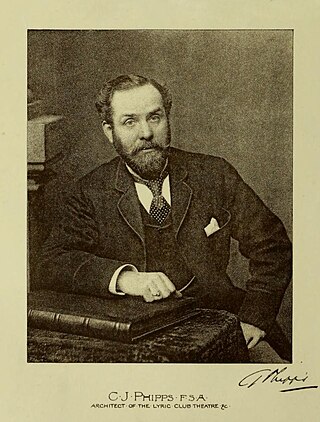Top Qs
Timeline
Chat
Perspective
C. J. Phipps
English architect From Wikipedia, the free encyclopedia
Remove ads
Charles John Phipps FSA (25 March 1835 – 25 May 1897) was an English architect known for more than forty theatres he designed in the latter half of the nineteenth century.
He began his own practice in his native Bath in 1857, designing buildings and furniture in the Gothic Revival style. In 1862 he gained his first theatre commission, the Theatre Royal, Bath, which generally retaining the Georgian character of the original theatre on the site. He moved to London in 1868, where he designed a variety of non-theatrical buildings, including the Royal Institute of British Architects’ own premises.
Four of his West End theatres survive: the Vaudeville, the Lyric, the Garrick and Her (now His) Majesty's. Eight others have been rebuilt in the twentieth century (including the Savoy and Sadler's Wells) or demolished (including the Gaiety and Daly's).
In the British provinces Phipps's theatres have fared better, with the prominent exception of the Theatre Royal, Exeter, which burned down in 1887 with large loss of life. Nine others have been destroyed by fire or bombs, rebuilt or demolished, but eight have survived, including the Theatres Royal at Bath, Brighton, Glasgow and Nottingham and theatres in Aberdeen, Eastbourne, Edinburgh and Northampton. Of his surviving theatres, all but one are Listed buildings – officially designated as of particular architectural or historic interest deserving special protection.
Remove ads
Life and career
Summarize
Perspective
Early years
Phipps was born in Lansdown, Bath in Somerset, the eldest of the three children of John Rashleigh Phipps and his second wife, Elizabeth Ruth née Neate.[1][2] He was educated at St Catherine's Hermitage, Bath, and then articled to an architectural practice in the city.[n 1]

After a sketching tour on the Continent, Phipps established his own practice in Bath in 1857, producing designs for buildings and furniture in the Gothic Revival style of George Godwin and William Burges.[3] In 1860 he married Honor Hicks of Enborne, Berkshire; they had five children, born between 1860 and 1872, four of whom survived into adulthood.[2]
In 1862 Phipps gained his first theatre commission – a replacement of the old Theatre Royal, Bath, which had been gutted by fire. He came first in a competition to rebuild the theatre, and created the new house around the shell of the old, making use of the walls that remained, and generally retaining the Georgian character of George Dance the Younger's original building.[4] As a 1901 biographer put it, this "marked the direction of a future career, at variance both with the wishes of his parents, who disapproved of theatres, and with his training, which was Gothic and ecclesiastical".[3]
London
Phipps and his family moved to London in 1868, living at 26 Mecklenburgh Square in Bloomsbury, which he made his office as well as his home. He designed some non-theatrical buildings, including a substantial reconstruction of the Devonshire Club in St James's, the new Carlton Hotel in the Haymarket, the 100-room Lyric Club near Leicester Square, flats in Shaftesbury Avenue, business premises in the Strand, Ludgate Hill and Moorgate, the Savoy Turkish Baths and the militia barracks in Bath.[3][5]

Other non-theatre designs included Leinster Hall in Dublin for Michael Gunn (opened in 1886 and replaced in 1897), the Star and Garter Hotel at Richmond (demolished in 1919) and the Savoy Victorian Turkish baths, the first in London to be lit by electricity.[6] Phipps was chosen to design the Royal Institute of British Architects’ own premises at 9 Conduit Street. The building is still there, although no longer occupied by the institute. Nonetheless it was as a theatre architect that he became best known.[7]
Theatres
Phipps more often designed theatres for straight drama, rather than music halls – the latter boomed later in the century and became associated with younger architects including Frank Matcham and W. G. R. Sprague.[1][7] Phipps's style was influenced by the great French theatres of the eighteenth and mid-nineteenth centuries, with, as a 1982 study puts it, "a solemn, seemingly solid dignity". The decoration of his interiors was restrained, unlike "the integrated high-key rumbustiousness of the later Matcham or Crewe theatres". A similar classical restraint was evident in the exterior of most of his buildings.[7]

Phipps established himself as the leading theatrical architect, designing, in rapid succession, the Queen's (1867), the Gaiety (1868), the Olympic (1870) and the Vaudeville (1871).[7] His West End theatres of the 1880s included the Savoy Theatre (1881), the Strand (1882), the Prince's (1884), the Lyric (1888), the original Shaftesbury Theatre (1888) and the Garrick (1889). His London theatres of the 1890s were the Tivoli (1890), Daly's (1893) and Her Majesty's Theatre (1897).
In addition to Phipps's London theatres, he was responsible for many more in the provinces. These included the ill-fated Theatre Royal, Exeter, which opened in 1886 and caught fire disastrously the following year: at least 150 members of the audience were killed. A parliamentary inquiry placed some of the blame on Phipps and his designs.[8]
Phipps's other provincial theatres fared better, and were established as far north as Aberdeen and as far west as Dublin.[7] Eight have survived including the Theatres Royal at Bath, Brighton, Glasgow and Nottingham and theatres in Aberdeen, Eastbourne, Edinburgh and Northampton. Of his surviving theatres, all but one are Listed buildings – officially designated by the Historic Buildings and Monuments Commission for England or Historic Environment Scotland as of particular architectural or historic interest deserving special protection.[9]
Phipps died on 25 May 1897, aged 62, and is buried in a family grave on the east side of Highgate Cemetery.[1]
Remove ads
Theatres by Sprague
Summarize
Perspective
In London except where indicated
- Source: Mackintosh and Sell; and Theatres Trust Database.[9]
Remove ads
Notes, references and sources
External links
Wikiwand - on
Seamless Wikipedia browsing. On steroids.
Remove ads

